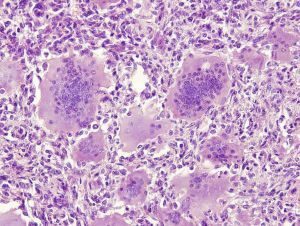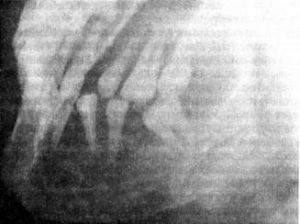 Often, bone tumors manifest unexpectedly for the patient.
Often, bone tumors manifest unexpectedly for the patient.
The causes may be bruises or fractures, but in most cases, specialists can not name the exact prerequisites that could cause these troubles.
Depending on the substance that triggered the build-up, benign and malignant bone tumors are distinguished.
The same principle treats: some neoplasms are not affected throughout life, if they do not harm the human body, while others are immediately removed.
Giant cell tumor of bone is removed almost immediately after detection by surgical removal. In some cases, the neoplasm is removed along with the limb.
Content of the article
- Concept and statistics
- Reasons for the manifestation of the formation
- Symptom of the tumor
- Diagnostic approach
- How are tumor formations removed?
- Complications and prognosis
Concept and statistics
A giant cell tumor of the bone( officially called osteoblastoklastoma) is a benign bone tumor consisting of a cluster of ovoid mononuclear cell formations and osteoclastoid giant multinucleate cells.
The presented disease is approximately 20% of all cases of bone cancer.
Giant cell carcinoma of the bone began to be studied in detail in the 19th century, although it was known about it back in ancient times. Until recently, this neoplasm was considered a disease of young people, in most cases of boys.
But recent statistics have shown that growths occur in people aged 15 to 30 years.
Reasons for the manifestation of
formation To date, the exact causes of the development of neoplasm have not been established. Some of the alleged factors are still being debated among scientists.
Specialists agreed on the opinion that the formation of a giant cell tumor can be affected by the following factors: 
- inflammatory processes of the bones and periosteum;
- injuries and bruises, which were obtained repeatedly in one place;
- trauma can also "translate" an existing benign tumor into a malignant status;
- on "transition" is sometimes affected by the onset of pregnancy in a woman.
Of course, when diagnosing a bone tumor, the causes of such a disease recede into the background. But people who fall into the risk group according to the list listed should be careful and attentive.
Symptomatic of tumor
Symptoms of the described neoplasm include:
- pain in the affected area, manifested by movement or palpation;
- above the affected area, a skin vascular pattern is observed;
- in the process of increasing the patient notices the deformation of the affected area, which, when palpated, causes painful suffering;
- there is a violation of the function of the joint nearest to the affected area or the entire limb;
- palpation of the neoplasm causes not only pain, but also a characteristic crunch.
Diagnostic approach

On the photo of the
jaw osteoblastoklastoma Diagnosis of osteoblastoclastoma begins with a general examination by a specialist.
Next, the patient undergoes a series of examinations, the beginning of which is due to the delivery of blood for the detection of the inflammatory process and other characteristic changes.
Accurate diagnosis of neoplasm occurs through the following studies:
- X-ray study - allows you to quickly determine the nature of changes in bone surfaces, and sometimes determine the structure of the lesion.
- MRI and CT - is designed to study the depth of the lesion and its composition.
- Tumor biopsy - is used to detect the composition of the tumor, if the experts have any questions. It is also often performed before surgery. It is a fence of a part of a tumor for a laboratory study of its composition and structure.
Based on the diagnosis, specialists determine the procedure and treatment regimen( if possible).
How are tumor formations removed?
As a rule, the giant cell tumor will not disappear by itself. Therefore, only a few methods are used here to remove the affected area:
- Surgical intervention is an edge resection of the affected area. It requires restoration of the removed part, since in some cases the giant cell tumor of the bone is removed along with the whole bone( sometimes with the joint).A similar decision surgeons and oncologists are taking to prevent a relapse of the presented disease. The restoration of the defect is carried out with the help of a special implant. If the build-up is removed from the child, the implant has the technical capacity to increase, as a result of which the operated child undergoes surgical intervention every 2-3 years.
- Amputation of the limb is extremely rare. The cause of such removal is the suppuration of the affected area or soft tissues due to the penetration of the infection into the body. Sometimes limb amputation is carried out in the presence of a tumor of huge dimensions.

- Radiation therapy - the method is used quite rarely and only in the presence of a small tumor, that is, at the initial stage of the disease progression. Under the influence of the rays, the tumor decreases in size.
- P adiradiation radiation - is used extremely rarely and only in cases of "hard access" to the affected area. Attracts a lot of unpleasant consequences in the form of diseases of internal organs. It is carried out by the course and does not always contribute to the complete elimination of the tumor.
The method of treatment directly depends on the course of the disease and other factors that were identified at the stage of diagnosis.
It should be noted that the giant cell tumor has a feature of rapid growth, therefore it is necessary to resort to diagnosis and treatment immediately.
Complications and prognosis
Complications of the disease can result in untimely treatment or infection.
Also on the complications of an existing neoplasm affect all listed above causes of the manifestation of the disease.
In the form of complications, its transition from a benign tumor to a malignant one, as well as the formation of metastases in the internal organs of a person, is distinguished. The lungs and other respiratory organs are more vulnerable in this respect.
Therefore, often an operation to remove a tumor can be postponed due to the minimal probability of a favorable outcome.
If a person in time to see a doctor, namely at the stage of manifestation of pain during movement or palpation, a favorable outcome of events has almost 100% probability.
Keep track of your condition and at the first occurrence, consult your doctor for diagnostic work.



